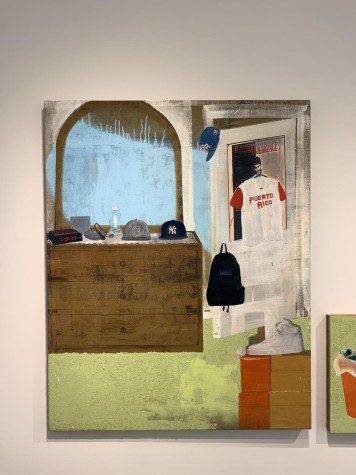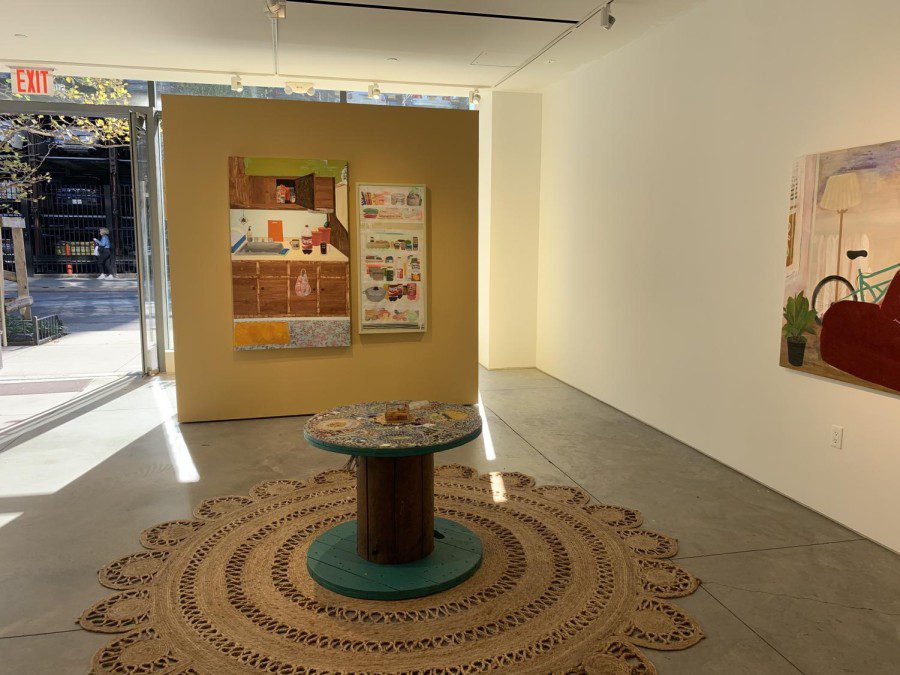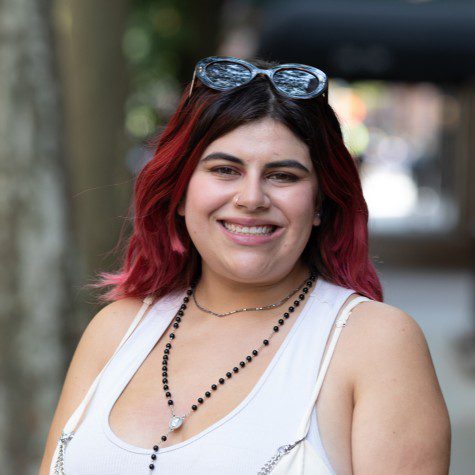Melissa Misla’s ‘What a Part of the Apartment Meant’ explores the complexities of Latinidad
“What a Part of the Apartment Meant” is a knockout show from Praxis Gallery that will run from Sept. 15 to Nov. 12.
Melissa Misla’s artwork is on show at the Praxis Gallery, located at 501 W. 20th St. (Courtesy of Natalia Palacino Camargo)
October 19, 2022
Unlike other galleries in the Chelsea Arts District, Praxis Gallery exclusively features the works of Latinx artists. Miguel Kehayoglu, the gallery’s founder and a textile entrepreneur, cemented his passion for supporting talented Latinx artists when he founded Praxis International Art in Buenos Aires in 1977. Kehayoglu, who is an Argentinian of Greek descent, united Hellenic traditional techniques and Latin American painting, and showed a deep commitment to art practices throughout his life.
This new avant-garde space proved to be a place of opportunity and culture, housing a rich collection of artwork from emerging and established Latinx artists. His vision to promote this art was expanded in 1987 when he opened the New York City-based gallery. To this day, the gallery continues to honor its founder by promoting and amplifying the work of Latine artists through its exhibitions.
Housed at their 501 W. 20th St. location, Praxis’ current show, “What a Part of the Apartment Meant,” is a solo exhibition featuring the work of Melissa Misla. Misla is a native New Yorker who works across mixed media and is interested in exploring the Nuyorican (Puerto Rican from New York) experience. Most of her work focuses on scenes from the Latinx home and from New York City housing. This exhibition specifically centers Misla’s relationship with her childhood. We get to see the everyday spaces that Misla inhabits, keeping in mind her personal history.
“Amid the ever-changing city, I have remained in the same apartment in Queens for over 28 years,” Misla wrote for Praxis Gallery. “As my work pays homage to past Latinx spaces, I created a series rendering my childhood home before I leave it behind.”
In this solo show — Misla’s second at the gallery — a set of mixed-media paintings allures viewers with its delicate yet youthful and childlike perspective. The use of rich colors, textures and recognizable logos — known to be deeply ingrained in Latinidad — resonate with a broad community that often lacks representation in the visual arts.
Large-scale mixed-media paintings like “Filled to the Rim” and “Feeding the Fam” both depict Misla’s kitchen’s wooden cabinets and the inside of her family fridge, and show collaged labels of food items that are familiar to many Latine people. The paintings include a rice pot with leftovers, a mix of popular American food from the 2000s like Bagel Bites, and Latine staples like Coca-Cola and Goya Foods — a popular Hispanic brand that sells everything from canned beans to frozen maduros. These items, while small and mundane, depict the reality of what it feels like to inhabit American spaces while trying to stay connected to your cultural roots, something people often attempt to do through food.

Similarly, the large-scale work “Fitter Forward” depicts the bedroom and dresser of what seems to be Misla’s family member, a young adult male. Items upon the dresser and hanging on the door speak of staples or symbols of Nuyorican and Latine identities — such as a New York Yankees flat baseball cap and baseball jersey. Baseball is a cultural landmark for many Latinos who have immigrated to the United States.
The use of bright colors, iridescent materials and collaged textures create fantastical depictions of the home, and the use of collage, with logotypes and popular iconography from Latine homes, allow this work to transcend the personal.
The mixed media work “Rice and Riches” depicts a yellow kitchen with yellow rice cooking on the stove, an antiquated coffee kettle, a kitchen towel with a rooster hanging on the oven door and a mantel with white lace over it. I remember all of these from my own kitchen and from my grandmother’s kitchen. I was instantly transported to my own childhood home in Colombia just by looking at this work. Misla’s work was powerful enough to immerse me in the nostalgia of my childhood. Latine people, whether living in the United States or in Latin America, can relate and connect to the work.
Latine visual artists have slowly cemented themselves into art history by defying expectations from the canonical art world, dominated by white male artists. Through the 20th century, artists like Frida Kahlo, Ana Mendieta and Felix González Torres defied the male artist stereotype by bringing queerness, multicultural identity and defiance to a system that continued to erase their experience.
While their work is currently housed in spaces like the Museum of Modern Art and the Guggenheim Museum, they are still exceptions — not the norm. Seeing their work through the lens of Latinidad also limits the conversation around the work. Latine people, women and queer artists often find their work to only be valued in spaces where their identity defines them. Their work is often only relevant when encased by the white-dominated worldview that leads to too much discussion of the identity or stereotypes assigned to someone, rather than the art itself.
Praxis Gallery is unique in its expansive mission to include Latine artists in the contemporary art world without trying to promote the artists’ work as solely applicable to their Latin American experiences. Although all of their artists share factors of cultural identity, the exhibitions stand by themselves as reflecting something much deeper, countering the all-too-common stereotypes about the Latine artist. The exhibitions do not try to frame themselves as selling some cultural fantasy, but instead include the works simply as they are.
Misla’s work stems from elements of her personal and familial space in the 2000s. Based on photos and memory, Misla’s art does not try to make a statement about what identity should be but rather honors the collective imagery of Nuyorican and Latinx interiors. The artist honors her personal narrative and presents childhood and adulthood through her identity with a refreshing and playful angle.
Contact Natalia Palacino at [email protected].



























































































































































